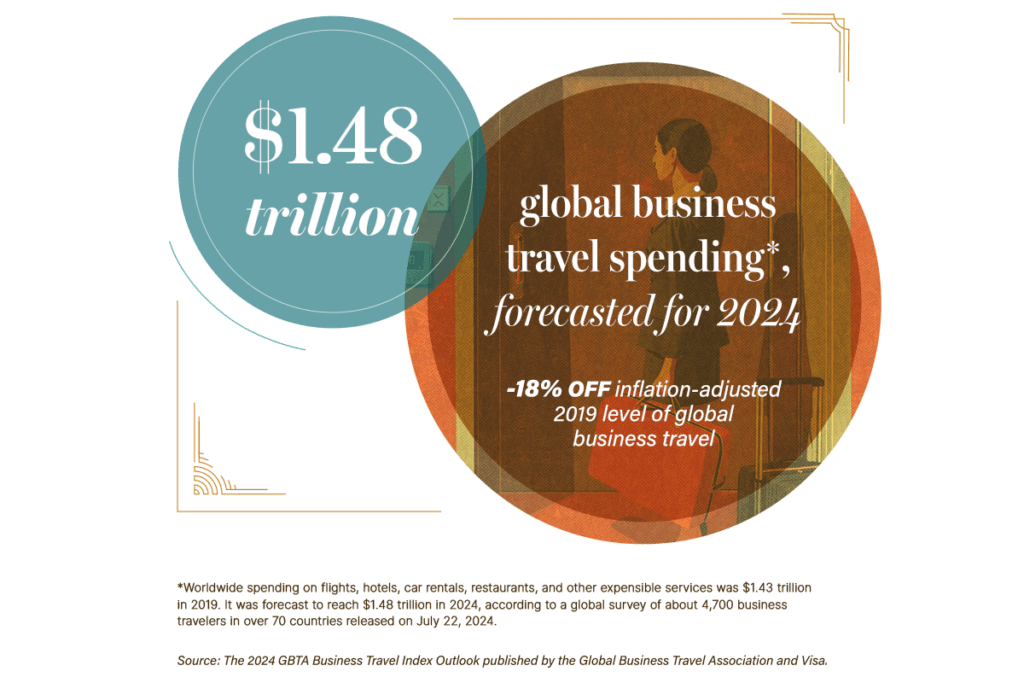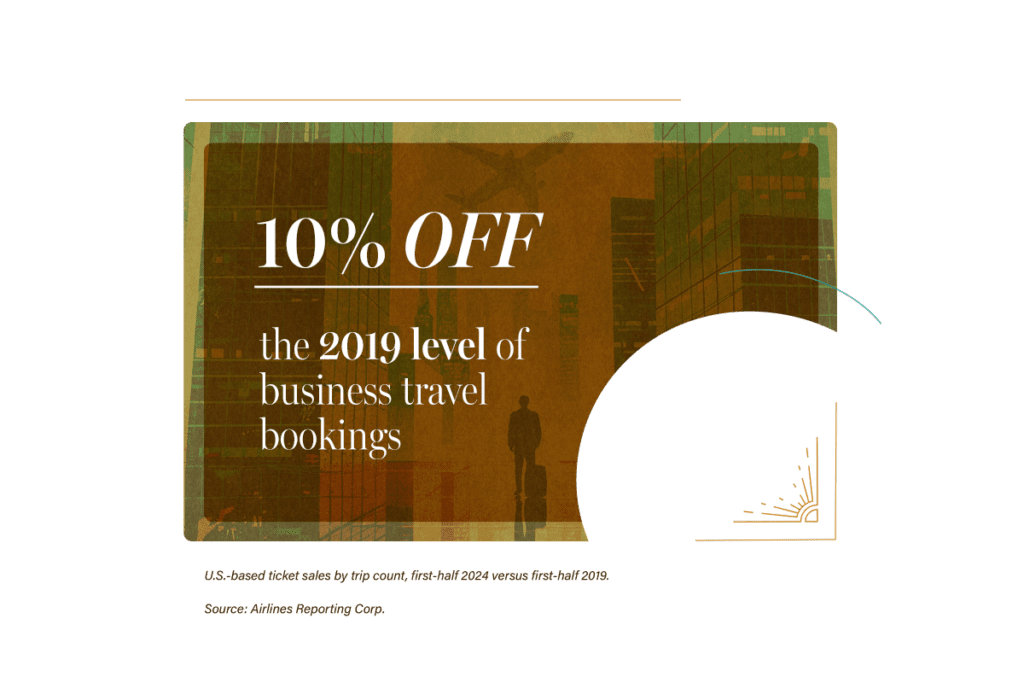Gloria Gonzalez, a travel agency account manager in Fort Worth, used to fly back-to-back business trips as a travel manager before the pandemic.
Drew Pinto, Marriott’s chief revenue and technology officer, still travels for work, but when he does, he thinks more about how flight times, jet lag, and other travel realities will affect him.
And Sophie Hulgard, Accor’s chief sales officer, has traveled almost weekly for years. But recently, she has become more conscious of the physical toll.
Gonzalez, Pinto, and Hulgard are part of a growing trend among corporate travelers. As long-time road warriors, they’re prioritizing their physical and emotional health for sustained effectiveness.
Business travel may be on its way back — but for many travelers, it feels very different.
“Maybe I’m not taking the red eye and going right into a meeting, but I’m instead arriving the night before, especially for international travel,” Pinto said. “There’s just this new mentality of being at your best when you’re on a business trip instead of fitting in as much as you can.”
Gone is the era of “more-is-more” business travel that George Clooney glamorized in the 2009 movie Up in the Air.
“It used to be you just rush, rush, rush — going from meeting to meeting,” Hulgard remembers. Now, she is more deliberate in evaluating what makes trips effective. And Hulgard is far from the only one.
Skift spoke to a few dozen frequent corporate travelers and travel managers, and some key themes emerged: First, corporations recognize the importance of in-person meetings, but at the same time, travelers have become more mindful and selective when planning trips.
And hotels are rushing to profit from this mindset shift.
Some brands are pivoting to cater to so-called “executive athletes” who demand more than just a bed. Trips blending business and leisure remain elevated, supported by hybrid work options — even though so-called blended travel is down from 2022 highs. Extended-stay demand is booming, driven by workers having protracted trips on infrastructure and tech projects. New software dashboards are helping travel professionals keep an eye on potential stressors.
The bottom line is that business travel feels different than five years ago. Skift has examined the trillion-dollar sector from a few different angles, noting some opportunities for hotel companies along the way.
Business Travel Isn’t Fully Back
While business travel spending will likely hit 2019’s level this year, it’s still off by 18% if you adjust for inflation. U.S. corporate travel ticket sales were 10% less than they were during the same period in 2019, according to Airlines Reporting Corp.
Many factors explain the incomplete rebound. Rising costs have deterred spending, and some corporations have capped travel to meet climate goals. Changed traveler behavior may also be a factor.
New Business Travel Patterns
People are taking fewer business trips in the last few months of the year than they did pre-pandemic.
March has been the peak month for business trips during the past five years, and June has come in second, according to CWT. But in 2023, there was a drop in the fourth quarter compared to pre-pandemic.
“This could be evidence of trip batching — choosing a region and doing multiple trips at once,” said Rich Johnson, VP solutions group at CWT.

Join the CEOs of Marriott, Wyndham, MGM, and more at the travel industry’s premier event.
Sept. 17-19 in New York City
The year-end decline in business travel might also reflect people’s greater emphasis on spending time with family during the holidays, Johnson noted.
Others have observed this trend, too, and forward bookings for late 2024 suggest there may be relative weakness again.
“What has changed post-pandemic is we’ve continued to see real softness in and around holiday weeks, and following holiday weeks that’s really affected business travel in a way that it hasn’t necessarily in the past,” said Jonathan Stanner, CEO of Summit Properties, which runs nearly 100 U.S. hotels.
Blending Business and Leisure
Some road warriors are adding leisure time to business trips to manage stress.
The rise of “blended” travel is reshaping industry dynamics. About 60% of business travelers surveyed by Skift Research in the first quarter said they had extended their trips for leisure in the previous three months.
“It’s very, very clear that the blended trip purpose of travel is here to stay, and that’s driving incremental room night demand, especially on what have been traditionally shoulder nights,” said Noah Silverman, global development officer, U.S. & Canada, at Marriott International.
Hybrid work arrangements fuel the shift, although remote working has become more occasional.
“Blended business and leisure travel isn’t happening as much as we saw a year or two ago,” said Ankur Randev, chief commercial officer at Highgate, America’s second-largest hotel manager. “But I definitely expect to see it happening seasonally, especially over springs and summers as parents manage children on holidays.”
Some properties miss opportunities because they lack appropriate amenities. Leisure-focused hotels could boost bookings by outfitting select rooms with ergonomic workspaces. Ennismore is aggressively pursuing this strategy, adding office setups to many of its leisure properties.
A Boom in Longer Stays
Extended-stay travel is also having a moment — fueled by massive infrastructure and tech investments. Hilton says “the workforce travel market” is worth $300 billion.
Who books these stays? Largely workers who temporarily relocate.
Take the U.S. government’s $1 trillion infrastructure package. When it begins in earnest, it will unleash a wave of construction projects needing a place to house workers.
Meanwhile, tech giants like Amazon are plowing $100 billion into new data centers. A surge in semiconductor manufacturing could inject over $220 billion into facility investments.
“If we look at extended-stay occupancy, it’s up 12 points higher year-to-date than the rest of the industry,” said Wyndham president and CEO Geoff Ballotti in a CNBC interview in July.
Wyndham’s rival, Choice Hotels, has seen an over 50% jump in workforce travel accounts it services since 2019.
“This surge is real,” said Choice Hotels president and CEO Patrick Pacious in a recent earnings call, noting expansion in “middle class, small business, construction, logistics” verticals. Pacious expects Choice’s number of extended stay units to rise at an average annual growth rate of more than 15% a year for at least a few years.
A demand-supply imbalance is exacerbating the situation. According to The Highland Group, U.S. extended-stay demand exceeds supply growth by 1.5 to 1.
This mismatch forces more long-term guests into traditional hotels that are ill-equipped for their needs. Brands that can deliver amenities like full kitchens stand to benefit most from this lucrative and expanding segment.
In the past two years, Marriott, Hilton, Hyatt, and Wyndham have debuted new extended-stay hotel brands, including Marriott’s StudioRes, LivSmart Studios by Hilton, Hyatt Studios, and Echo Suites Extended Stay by Wyndham.
Health and Safety Concerns
What does health maintenance commonly mean in a business travel context? It’s all about productivity — thanks to a healthy body and a clear mind.
“Wellness isn’t a massage chair or a first-class seat,” Hulgard said. “It’s instead about minimizing factors that can reduce an employee’s productivity on a trip. It’s also about avoiding burnout, which can lead to attrition that adds to a company’s hiring costs.”
Safety is an under-reported aspect of business traveler contentment. Half of global business travelers — especially American travelers — have had to change their accommodations because they felt unsafe, said a survey this year of 3,850 business travelers by SAP Concur.
One reason? Some companies keep their travel and expense budgets tight. Employees default to booking stays in hotels that accidentally turn out to be in dodgy neighborhoods.
Hotels Lean Into Health
Travelers’ interest in maintaining their health creates opportunities. Healthier guests may be happier customers willing to splurge on extras. Hotels are addressing sleep deprivation, poor diet, and fitness needs with targeted perks and services.
IHG now offers InterContinental guests free access to the Timeshifter jet lag app, which can help guests plan meals, sleep, and exposure to sunlight. Other hotel companies are focusing on noise reduction through amenity kits with earplugs and white-noise machines and apps.
Regarding fitness, hotels can do more than merely have a windowless room with some weights and a treadmill.
“Our surveys find that travelers are increasingly focused on maintaining their fitness routine and health while traveling,” said Christiane Cabot Bini, vice president of global business travel sales at Hilton.
In the past year, Hilton has added at least one Peloton machine to every one of its U.S. hotel properties. Hyatt offers in-room Peloton content and equipment at about 400 U.S. properties. It even rewards usage with loyalty points. Accor touts its Technogym fitness equipment.
On the diet front, InterContinental added nutritious dishes to combat energy slumps. Marriott and Hilton are testing zero-proof drinks for those looking to socialize without alcohol.
Travel Dashboards for ‘Executive Athletes’
Should corporate travelers be treated as the elite competitors of the boardroom? Yes, says Ted Finn, who has flown 2.5 million air miles as a business traveler and consultant.
“We need to redefine road warriors as executive athletes,” Finn says. “You send your executives to competitions to compete for millions of dollars worth of business opportunities, and you expect them to win.”
Should executive athletes prep for travel like a sports team? Some companies have begun asking their travel managers to track health issues. A year ago, CWT launched a “traveler well-being dashboard” module in its software platform for customers.
“The dashboard looks at the stress and impacts of certain traveler behaviors on their well-being,” said Rich Johnson, vice president of CWT’s solutions group.
If everyone on a team is always taking red-eye flights or flying long-haul in economy class, the well-being score won’t be as high as it could be.
“This information might influence a travel buyer’s negotiations with airlines,” Johnson said. “Maybe a carrier has imperfect scheduling that’s creating a huge amount of fatigue on the travelers, who aren’t closing deals or who are leaving the company.”
Corporate Travel’s New Vibe
Business travel’s incomplete rebound reflects more than corporate belt-tightening in the face of inflation. Changed industry attitudes are also reshaping the sector.
“Five years ago, I think everybody wanted travelers to have a better life, but no buyer wanted to say it,” said Hulgard of Accor. “You couldn’t introduce any wellness aspects into your corporate travel program because you would look weak.”
But that’s no longer the case. “Today, it’s completely the norm that travel managers are looking at aspects like security or fitness options in the hotel,” Hulgard said. “It’s a conversation that hotel account managers have with the buyers. That’s a big change.”
Sean O’Neill is the senior hospitality editor at Skift. Contact him at [email protected]
Graphics by Vonn Orland Leynes.
Have a confidential tip for Skift? Get in touch.


